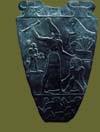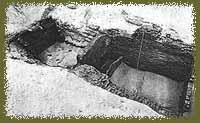Titulary
| Horus Name | Narmer, "Catfish" |
| Alternate Names | possibly the semi-mythical "Menes", although many believe that his son, Horus Aha, was Menes. |
| Approx 3100 BCE | |
| 3080-3040 BCE | |
| grimal | 3150-3125 BCE |
| Predecessor | |
| Successor | Horus Aha, probably son |
| Son | probably Horus-Aha |
| Chief Wife | Neit-Hotep |
| Buried in Abydos, B17-B18. This is a large mastaba of two joined chambers. B18 collapsed and was rebuilt. Nearby is his wife's mastaba (much larger than his!) and that or Horus Aha. |
| unknown |
Pharaoh Narmer has for some reason always been put outside the dynasty scheme, but since the Egyptians themselves from the very beginning recorded him as their first king, there is no reason not to give him prime position in the line of rulers.
 In the first years of the 1900s his tomb was excavated by the famous English egyptologist Flinders Petrie at the cemetery in Abydos, the oldest royal burial ground known in Egypt. In the 1990s the site was excavated again by German Egyptologists, and another tablet depicting Narmer was found.
In the first years of the 1900s his tomb was excavated by the famous English egyptologist Flinders Petrie at the cemetery in Abydos, the oldest royal burial ground known in Egypt. In the 1990s the site was excavated again by German Egyptologists, and another tablet depicting Narmer was found.
He could well have been named Nar-bedjau or something similar. His name does not appear in later king lists, though he had so many written remains during his lifetime. Many of them are found on jars in grave from Tarkhan, the possibly last stronghold for the southern kings of Thinis before the final push northwards to make the revolution complete. This indicates that his reign was prior to Menes, the legendary unifier of the two Egyptian lands according to Greek historian Manetho, living in Egypt in the 200s BC.
There are many things about Narmer pointing in the opposite direction - that he was Menes. His name was first in line of kings from seals during the first dynasty, and his name has been found from Syria in the north to Nubia in the south, but only on petty things like jars, potsherds and labels.
 The only monument left after him is his tomb with its massive walls at the cemetery B in Abydos. The wall dividing the two chambers seem to have been far to thick in the drawings made a hundred years ago, and was rather a double construction for a mini-chamber in between the big ones. [image; touregypt.net]
The only monument left after him is his tomb with its massive walls at the cemetery B in Abydos. The wall dividing the two chambers seem to have been far to thick in the drawings made a hundred years ago, and was rather a double construction for a mini-chamber in between the big ones. [image; touregypt.net]
pharaohs
sekhen
iry-hor
ka
"crocodile"
"scorpion"
"scorpion II"
narmer
dynasties
pre-dynastic kingdom
dynasty 0/00
Related Links